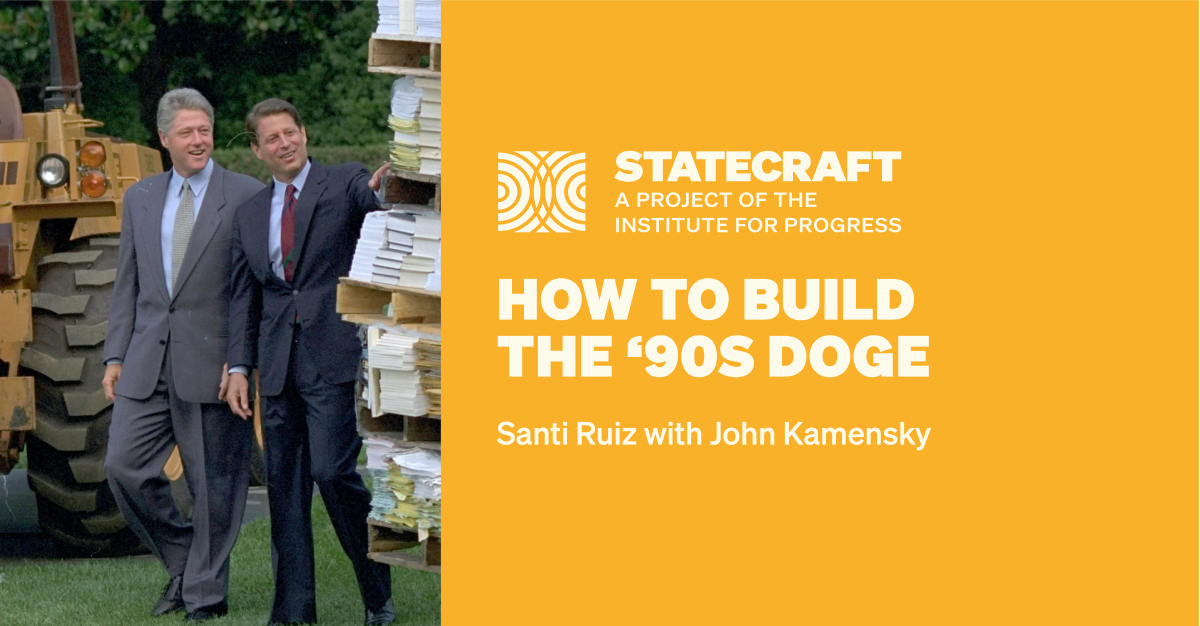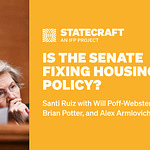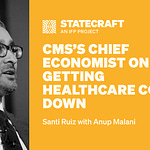Today, we’re taking a look at a predecessor to DOGE: The Reinventing Government project (officially known as the NPR, for National Partnership for Reinventing Government). The NPR ran for almost the full duration of President Bill Clinton’s two terms, and led to the elimination of over 100 programs and over 250,000 federal jobs.
Both NPR and DOGE are case studies in a long history of government reform efforts — some more successful than others. Our guest is John Kamensky, who served as Vice President Al Gore's deputy for the National Performance Review (NPR) for eight years. Kamensky was colloquially known as “Mr. Checklist” for his work organizing the Reinventing Government initiative.
Kamensky is a clear-eyed observer, and he doesn’t hedge about NPR’s failures and missed opportunities. In some ways, the Reinventing Government Initiative was a once-in-a-lifetime opportunity to cut headcount, spending, and regulation at the end of the Cold War and change the way the government operated.

We discuss:
Did the NPR actually work?
What was the Board of Tea Experts?
Why was the federal government subsidizing mohair?
NPR made the federal workforce older. Was that bad?
What doesn’t Elon understand about the federal government?
As I understand it, the Reinventing Government initiative was the longest-running government reform project in American history.
Yeah, that's how I understand it. I’ve researched previous reform efforts from the past century and haven't seen anything that had that kind of endurance.
In broad strokes, would you call the initiative a success?
I would say yes, it was a success. It changed what government employees understood their jobs to be. The goal was to empower them to be able to get results, and they felt that in many cases. We conducted a survey and found that after eight years, 40% of the civil service understood what we were trying to get at — that’s enough to create some momentum.
Even in future administrations, people still talked about some of the initiative’s outcomes. There were about 100 different statutes that included bits and pieces of our recommendations, and a number of administrative changes, like designating the deputy secretaries for various departments as chief operating officers and having them meet government-wide as the President's Management Council. I believe that has continued until today, although I don't know what the current administration's approach has been.
You’ve flagged that government reform efforts like NPR and DOGE are a recurring feature of American policy. Can you place the NPR in the context of the history of government reform efforts?
Yes, when I was researching government reform initiatives while at the Government Accountability Office (GAO) in the late 1980s, I identified 11 in the 20th century alone. It started with the 1904 Keep Commission, and then the 1937 effort that was undertaken during the New Deal under FDR. The most famous was the 1947-1949 Hoover Commission, which led to probably the most substantial organizational changes. And then in 1955, there was a second Hoover Commission. The first Hoover Commission focused on how the government does its work and led to the creation of the General Services Administration (GSA) and the National Science Foundation (NSF). That effort also led to the creation of a single overarching Defense Department across the different military services.
The 1955 Hoover Commission was more focused on what the government should be doing, which led to competing functions between the government and the private sector. The idea was to eventually transition those services to the private sector, which didn't go over quite as well as the efforts in 1949 had.
There’s a long history of approaches to government reform: there were efforts under Johnson and Nixon, and the Grace Commission under Reagan. Typically, advisers outside of government came in to advise on best practices from the private sector, but the Reinventing Government initiative was different. We turned to civil servants and asked them what needed to be done to fix government operations, focusing on the “how” and not so much on what the government should be doing.
What was the policy conversation like in the late ‘80s and early ‘90s, before the Reinventing Government initiative?
This was toward the tail end of Reagan’s Reform ‘88, which were largely administrative reforms. In the late ‘80s under President George H.W. Bush, the focus shifted to improving government performance and financial management, which led to the passage of the Chief Financial Officers Act (CFO Act) in 1990. I was at the GAO at the time, and I was tapped to look at how to measure and improve government performance. I wound up looking at what was going on in other countries as examples.
What was the insight that you were looking at?
Under Senator Bill Roth, the Senate Committee on Homeland Security and Governmental Affairs tried to create legislation that defined performance measurements in government. There was skepticism from the Office of Management and Budget (OMB) as to how that might be done. [NB: We’ve interviewed former OMB senior advisor Cristin Dorgelo and current Director Russ Vought for Statecraft.] Charles Bowser, then GAO comptroller general and my boss, wanted to support Senator Roth by creating a parallel effort to improve performance accountability. I was tasked with looking into how to make what eventually became the 1993 Government Performance and Results Act realistic in the US context.
After going abroad to study the approaches of other countries, I heard a talk by journalist David Osborne, who later published a bestseller called Reinventing Government. He’d visited multiple states to see how they were transforming their operations. I told him, “What you're describing is exactly what I'm seeing in these other countries.”
So this was in the global gestalt, and academics eventually called the movement new public management theory. The idea was that you could use business concepts — like internal competition — to improve service efficiency and the government's ability to deliver for its citizens.
So you're at the GAO in the late ‘80s. How did you end up at the Reinventing Government initiative?
David Osborne and I had an ongoing conversation — he was fascinated by what other countries were doing, and I was fascinated by what he was finding in the states. In a previous book called Laboratories of Democracy, he did a case study of Bill Clinton’s governorship of Arkansas, so he was in the Clinton circle. During Clinton’s presidential campaign, David Osborne drafted a speech on how Clinton could reinvent the federal government. That speech was never made, but the ideas stuck.
When they organized the transition team, Al From of the Progressive Policy Institute was leading the government reform piece. They brought in John Sharp, who was running the Texas Performance Review, and it was more like DOGE. They went into the agencies and terrorized them to find savings. On David Osborne’s suggestion, they came to me to get the international perspective.
Then in early March of 1993, Clinton gave a press conference, and said the administration would create a National Performance Review. I called my counterpart at the OMB to ask what was going on, and he said, “Well, this is the Clinton administration. This is live and unrehearsed. We don't know what's going on.”
A few days later, I get a call from Elaine Kamarck, and she says, “I just started working for Vice President Gore. He was asked to do this reinventing government thing, and David Osborne says that I need to talk to you.” They called me, Bob Stone, who was doing the reinvention of the Defense Department, and Bob Knisely, who was over in the Department of Transportation.
I told them what was going on in other countries. Bob Stone was a sort of renegade in the Defense Department, a civilian in charge of the Department’s military installations. He oversaw a large team and was trying to delegate authority; rather than having them ask whether to repave a parking lot in San Diego, he said, “No, you know whether you need to repave it, don't ask me.” So he talked about how the DoD had screwed up. Bob Knisely had worked in a lot of different civilian agencies and saw parallels there.
Elaine suggested we tell the Vice President about it. The three of us met at Bob Stone's house to figure out what we would tell the Vice President, because this was our one chance as civil servants to say what needed to be done to fix the government. Clinton had actually done total quality management when he was the governor of Arkansas and wanted the Reinventing Government initiative to consist of civil servants, rather than turning to business executives as Reagan had.
Bob Stone had developed a set of principles for his model installation program and suggested we use those. He made this “gold card,” which had those principles and Clinton and Gore’s names on it. Over the years, we handed out those cards to around 100 civil servants, but the first gold card was made in the middle of a snowstorm at Bob's house to give to Gore at our meeting the next day. Bob Stone is a storyteller at heart, and he said that we really needed to convince him of how screwed up the government is. He had a box of his “toys”: examples of how idiotic things were in the Defense Department. We decided to take it with us to the White House. The vice president has an office over in the corner, which Gore called the Square Office as opposed to the Oval Office.
The next day, we went and sat down with him, Elaine, and the deputy director for management of OMB. After we each told our stories, Bob Stone brought out the box. He took out a can of spray paint and told a story: the Defense Department hired chemists with chemistry degrees and tasked them with making sure that each can of spray paint hadn’t expired. They had to sign a little form that's stuck to the side of each can to say that the paint is still useful.
Then he pulled out a steam trap, which is a metal valve that takes dirt out of steam lines in buildings. These each cost about $100, and when they start leaking steam, they leak about $50 worth of steam a week. But the procurement people wouldn't buy a replacement until they got a bulk order. That let them get them for $90, but it took about a year to get enough orders, and you lost $50 worth of steam a week in the meantime.
Gore found this idiotic, and Bob Stone suggested letting the engineers on the base buy small items using a credit card rather than going through the procurement system. At the end, Gore asked us to come on for six months to help. I’d had no idea this was a job interview.
Bob Stone was running the base closure effort for the Defense Department and wasn’t sure he could do it, but Gore said, “I’ll talk to Les Aspin, I’m sure he’ll let you go.” [NB: I’ve interviewed my dad, Diego Ruiz, about his work on the base closure commission for Statecraft.] Bob Knisely was the acting director of a brand new agency created by Congress, the Bureau of Transportation Statistics, and wasn’t sure about leaving. And I needed to ask my wife.
I knew that getting detailed from the legislative to the executive branch would not go over well at GAO. Sure enough, Senator Roth was on the floor of the Senate a few weeks later, saying that this is a violation of the separation of powers. So I resigned from GAO and was picked up in the executive branch.
Vice President Gore was initially tasked with turning around a report on reinventing government in six months, for which he brought on a temporary task force of about 250 career civil servants. But you and this program stuck around for eight years. What happened in those first six months?
We also brought Billy Hamilton on board. He was the director of the Texas Performance Review for John Sharp in Texas. We had to create a new agency from scratch, and we had no office space, nothing, just some temporary space over in the New Executive Office Building. So we started making calls to recruit people from agencies. The idea was to have a staff of about 35–50 people. Billy Hamilton would oversee a set of teams that focused on the agencies, and I would have a set of teams that looked at government systems. At GAO, I’d learned that agencies are so constrained in what they do that they can't fix themselves. We needed to fix the broader systems, like personnel and procurement.
We planned a public launch at the Old Executive Office Building for April 15, 1993. I'd drafted charters for each of the teams — there were about 14 systems teams, and Billy had about 24 teams for each of the major agencies. When we got to the building, there was a line outside. Hillary Clinton was running her healthcare task force at the time, so I asked if that’s what they were there for. And they said, “No no, we're here to reinvent the government.” When I got inside, the place was packed. Around 250 people showed up, and we didn’t know where they came from.
And you had planned for 35 to 50?
Yeah, and that’s how much office space we had. Bob Stone turned to an Air Force colonel who stood up military bases in hostile environments, and asked him to help us find more office space. He found the old headquarters for Clinton’s presidential transition team, and we commandeered the building. Stone also went to GSA and said, “We need computers.” The GSA said they didn’t have that many computers handy, but there was a shipment coming in for the new White House staff. This guy commandeered that shipment. The White House staff always thought GSA was incompetent, but we weren’t.
We began breaking out into teams. Billy Hamilton implemented a process that he called “tollgate,” where once a week, every single team presented what they were doing and their findings to a board of myself, Bob Stone, Bob Knisely, and Billy Hamilton. As we worked, we began reconstituting some of the teams and moving things around because we were finding some overlaps. Eventually, the Vice President asked to get involved, but Bob Stone felt that we needed to have him out of the way to do our work. Bob had this brilliant idea to send Vice President Gore out to the agencies to have town hall meetings with employees. That turned out to be a really big deal.
Why?
A vice president had never been to most of those agencies in person, so it created enormous buzz. He went from the US Department of Agriculture to the Department of Housing and Urban Development (HUD) to the central courtyard at the Pentagon, and huge crowds of enthusiastic employees showed up. The Vice President was on stage with the department secretary to listen to these people, and they would talk about some of the most embarrassing things going on in their departments that the secretary, of course, knew nothing about. And the Vice President was sitting there taking notes. When we finished our draft report, Gore asked us to change it to reflect some of what he had heard and make recommendations based on those stories.
One lesson I’ve learned from doing Statecraft is how much political cover matters. It's one thing for the president to say, “Go do this” once. But a clear signal that political leadership cares about seeing a project through to completion, whether that's NPR or DOGE, makes a huge difference.
What was interesting is that in the first six months of most administrations, you don't have the political appointees there.
They're not confirmed yet.
Yeah, and the lower-level Schedule Cs haven’t been appointed yet either. There are about 1,500 of those, and another 1,200 political appointees who are confirmed by the Senate. It was basically the career civil servants and not the political appointees who were crafting the recommendations. George W. Bush actively involved his political appointees, whereas the Clinton administration brought them in later.
On the systems teams, I intentionally mixed people who were experts on the system, like procurement, with people who were users of the system. There were many clashes between them about how they saw the world and which changes needed to be made. That was a creative dynamic in financial management and budget, and my job was to referee. In fact, one team had an internal divorce because they couldn't agree on something.
What did you prioritize in those first six months, and what did you leave on the table? That first set of recommendations did not include moving around agencies or consolidating functions.
Gore had very few dictates on what we should or shouldn't do. One of them was, “I don't want any recommendations to study this more. I want recommendations to do something.” Another was, “Don't move boxes. Fix what's inside them.” That was really sage advice, because typical government reformers want to make an org chart look rational by moving things around, even though it’s really hard and costly to do.
The last major department that we created was the Department of Homeland Security, and that was more than 20 years ago. That was really painful to create, and it took years to actually become functional. Gore believed that we had good people trapped in bad systems, which was the total quality management, W. Edwards Deming-type thing. That was sort of the mantra.
Do you think that gave NPR a longer political runway than DOGE has had? DOGE has taken on some reorganization initiatives, which come with a much higher political cost. You engender a lot more opposition.
In the second round of reinvention in ‘96, after Newt Gingrich became Speaker and the House went Republican, the NPR was asked to do a new report and study. That one was focused more on what government should do, rather than how. And much like the second Hoover Commission, it didn't land very well. Agencies were eliminated, the Interstate Commerce Commission was eliminated. My favorite was the elimination of the Board of Tea Experts, which was created in the late 1800s.
How do I get a job with the Board of Tea Experts?
I have no idea what they were doing. It was located in New York City because that’s where they were importing the tea. [NB: Although the Federal Tea Tasters Repeal Act was passed in 1996, the Board of Tea Experts wasn’t formally terminated until September 19, 2023.]
Another one that I had to look up, which is showing my age, was the cancellation of mohair subsidies.
Yes, that was one of the things from the Korean War. Mohair was considered a critical material because it was used to make gloves and socks for the troops. That subsidy never went away after the war ended, but we managed to kill it eventually. It actually came back after Clinton left office.
With DOGE, Elon Musk has focused on holding up really egregious examples of government spending. They’re often overhyped or taken out of context, but showing millions of Twitter users what they’re cutting has been a huge focus. How much did the Clinton-Gore administration tout those examples of waste in public?
We didn't do that during the first six months. Then we issued the main report and there was a big event on the South Lawn. After that, there were 38 accompanying collateral reports for each of the agencies and systems on how to implement the recommendations in the main report. Promoting the things that were screwed up wasn’t such a big deal, and the GAO was finding a lot of them. Like, there were about seven agricultural field offices in every county in the United States.
Really?
Yeah, five to seven Department of Agriculture field offices in each of approximately 3,000 counties, including Brooklyn. There were all of these different agencies, and the Department never co-located field offices. We found closing the offices really hard because members of Congress wanted to keep them. The story that we got was that there were so many field offices because President Lincoln had said that no field office should be further than one day’s horse ride from any farmer, so field offices were about 20 miles apart.
That’s incredible. I live in Brooklyn and there are a few chicken coops in my neighborhood, but that's about as agricultural as we get.
After those first six months, was there political appetite for going further? This obviously extended into a much longer project, but what was the reception?
The initial report was fairly well-received, but there were some complicated dynamics. Many recommendations required statutory changes. David Osborne opted for one big reinventing government bill, but those of us who were in government knew that wouldn’t quite work: A big bill would need to be sent to different committees based on their jurisdiction, then come back together, go to the other house of Congress, get split again, and come back again. We knew that would never work, and sure enough, that bill went up and it didn't pass.
We ended up working with the OMB through the annual appropriating and reauthorization process, and wove this stuff in over the next few years, and eventually a lot of that stuff passed into law, but it wasn't a single big bill.
Will you explain for our readers what it means to work with the OMB to get that into legislation?
Well, I’d left the GAO to the executive branch, and there was tension between the National Performance Review and OMB. OMB said, “We’re the Office of Management and Budget. Management is our middle name, and you guys are doing it.” Bob Stone had a meeting with Alice Rivlin in the Vice President's offices and said, “We're here to reinvent the government, and you are the government.” That didn't go over too well. I did eventually become an OMB employee, so they had to treat me nicely, or at least give me a phone number.
Here’s something that shocked me: the NPR report was one of the first government documents posted on the Internet, and within days it had over 100,000 downloads and hit the New York Times bestseller list. This was a federal report on government processes, but it blew up. I'm guessing you guys did not expect that reception either.
Well, the main report was drafted by David Osborne. He was a journalist, so he knew how to write. He and a team of other journalists combed through the accompanying reports from all the agency and system teams, which were written by career civil servants who wrote like career civil servants, and he teased out the really interesting stories and key recommendations. So he and his writing team came up with this incredibly readable report, and instead of using the Government Publishing Office to format and publish a dry government report, we went to a private sector company and they came up with a design for the layout. You can’t find that on the Internet because PDF wasn’t quite public yet, so online it’s just in Courier font right now. When I went to read it, I couldn’t believe that this was a government report.
James Q. Wilson, one of my favorite political scientists, said, “In my judgment, the Gore report is the best White House statement I have ever read about what citizens really want from government and administrators.” You don't often see praise like that from outside observers.
Let me ask you about some of the more difficult parts of NPR. The initiative famously cut upwards of 400,000 civil servants over those eight years; it wasn't until the last five years or so that the number of full-time federal government employees approached that 1993 peak again. How did you figure out where to cut headcount and implement it?
One later criticism of NPR was that as the number of federal employees dropped, a lot of outside contractors and what you might call Beltway Bandits ended up doing a lot of that work instead. You had this kind of dark matter version of the federal workforce: it just wasn't on the books full-time.
This goes back to empowering employees, which was one of Bob Stone’s mantras for the project. There were too many overseers and people in mission support functions — one in three civil servants were middle managers in what we called “management controls” — procurement, budget, personnel, legal. There was a 1:7 employee-to-manager ratio. Bob Stone was inspired by the business writer Tom Peters, who said that the average in the private sector is 1:15. That overhead is closer to 15% rather than 30%, so we set those two metrics as targets.
We wanted to go from 700,000 employees down to 350,000: moving 100,000 to the front line for service and returning the savings for the other 250,000 to the government. We had an initial target of 252,000, but agencies wound up cutting even more, in part because of the downsizing in the Defense Department after the end of the Cold War. We were looking at transferring some functions, like cooks, groundskeepers, and security guards at Veterans Affairs (VA) hospitals, to the private sector so that the government doesn't have to manage this enormous workforce. We saw how other countries implemented new public management theory to let agencies focus on delivering their core service and not managing police and groundskeepers, so that was the concept.
It didn't pan out that way because when we asked the agencies to cut headquarters, headquarters cut the field. And OMB wasn't really bought into what we were doing to reshape the workforce, so they let the agencies do whatever they wanted to.
Why wasn’t OMB bought in? That seems like a classically OMB thing to focus on.
Part of it was that they didn't think that the Reinventing Government people were rational. We were not traditional.
Because you were head-in-the-clouds folks?
A bit of that, but also that we were trying to empower employees, and that wasn't their shtick. OMB was more into top-down control. They have changed over the years — in fact, one of NPR’s outcomes was changing OMB, so that instead of being just budget analysts, they became resource managers. It wasn't just about money, but about how agencies function, and looking at their management and regulations.
But this didn't roll out the way we had envisioned it. There were some cases where it did, like when Jim King, who was the head of OPM at the time, cut down HR regulations and got rid of the 10,000-page personnel manual that agencies were expected to abide by.
He also worked with the agencies to downsize their staffs. That resulted in some hiring freezes, so you wouldn’t have new cohorts fall in over the years. Because of that, a gap of experience emerged, especially in procurement, which cascaded over the next 20 years.
Is that the gap the Beltway Bandits grew to fill?
In some cases, they did, but there are some functions that you just can’t delegate, like signing authority on contracts or coming up with contract strategy. We were hoping agencies would simplify HR and the procurement rules, which would let them do with fewer staff. But Congress ate dessert first and cut the number of people without simplifying the rules.
Is that what we're seeing with DOGE, where they start with the headcount cuts and hope that the regulatory cuts come later?
No, they think AI will fix it all, but it will be hard to have AI in the national parks to help someone who sprained their ankle. But they should have engaged Congress on the changes to the systems. In this current administration, we're not seeing any interaction that I can see with Congress of changing the rules of the game.
With those hiring freezes, there was a shift in the demographic composition. Federal employees started to skew older, and the share of federal workers under 35 fell by about 10% over the eight years of the NPR.

When you combine that with the median GS grade, the median place on the pay scale in the federal government is higher now than it was 20 years ago. That makes it a lot harder to fill roles with junior talent, or bring people through the ranks from a young age.
What do you make of that effect of the NPR?
There's also a shift in the mix of work that's done. For example, during NPR, the HR processes and agencies were manual, and they have since become electronic. In many agencies, small-time procurements were manual, and you had triplicate forms that took weeks to complete, and the administrative cost of processing those forms was horrendous, so they moved to credit cards. Interestingly, the current administration has reneged on the use of credit cards, and it's costing the government money. In fact, when there was credit card abuse in some agency late in the Clinton administration, Congressman Pete Sessions put in a bill to stop the use of credit cards, but the Congressional Budget Office came back and said, “That'll cost you $100 million in rebates.”
That's amazing. The rebates were a substantial chunk of money.
Yeah. You have to balance risk with the ability to get stuff done. If you want no risk, it’ll be very expensive.
Right. The current administration wants to centralize procurement at GSA, and we've seen some moves in that direction. As you describe, there's a constant pendulum swing between pushing purchasing and management authority lower into the system, and then realizing the risk and pulling it back. Then, once it's centralized, you realize that you've limited your ability to trust the outer branches of the federal government.
There are pros and cons of centralizing. One of the things that we saw was that, at the time, the US government was the last vestige of Soviet central planning. We needed to devolve that. The government had a choice between different administrative service centers, which we call franchise funds, and those still exist today. There were six or eight different franchise funds created across the government, so the Department of Health and Human Services would be able to service contracts and HR for other agencies, which allowed for transparency about how much an administrative process costs and created some competition between agencies. If an agency head gets fed up with how their procurement contracts are done, they can go to another agency. By recentralizing, you will initially gain some efficiencies, which will turn into inefficiencies over a few years as it becomes a non-responsive monopoly.
What do you most wish that the NPR had done differently, and what do you most wish had stuck from NPR that did not carry over to future administrations?
There's actually a relationship between the two. One is the ability to have employee engagement across administrations. I have no idea how to actually make that happen, you can’t administratively force people to work together.
What do you mean by that?
If you work across agency boundaries and you want to empower people to get their jobs done, that often requires working with other agencies. For projects relating to the environment, it's the Environmental Protection Agency (EPA), the National Oceanic and Atmospheric Administration (NOAA), the Department of Agriculture, and the National Park Service. How do we create a cadre of people who have experience working across agency boundaries? We saw that in other countries, and in the military with the Goldwater-Nichols Act in the ‘80s. We never quite figured out how to create a functional approach to working across agency boundaries.
Another thing that never quite got off the ground was the ability to link performance information to budget information. They seem to be in different offices administratively and don't quite ever connect, so you cannot consistently figure out the unit cost of X. Some cities have done this, though. New York City has come up with “million-dollar blocks,” which are city blocks that deliver $1 million or more of social services. They then create a team that works with that block across all the agencies that have social services there and deal with people and their problems, not with all the different programs and agencies. I don’t know how to do that at the federal level.
Let me ask a historical perspective question. Gore ran for president in 2000 and lost narrowly to George W. Bush, and then a few months later, 9/11 happened, and the whole political landscape changed.
Would the impact of NPR have been different without 9/11? It seems like the 21st century suddenly takes this turn in a much darker direction than maybe the Clinton administration expected. This is a Cold War end-of-history question — the world we enter is very different from what we expected in the ‘90s. Is there a counterfactual there?
From the Reinventing Government perspective? Not really. When Bush became president, he had a different vision of how he wanted to do management reform. He created the President's Management Agenda, which I think existed up until this administration — I don't know whether they're going to create one or not.
Bush wanted to focus on the mission support systems, and they created a five-part scorecard and agenda. They engaged their political leaders in pushing this agenda as opposed to the career staff, which the Reinventing Government initiative had tried to do. President Bush appointed Clay Johnson, who was his roommate in college and was his chief of staff when he was governor, as head of the Presidential Personnel Office. But Clay Johnson really cared about management and wanted to make sure that everybody who came into the administration adhered to this five-part agenda. Once those people were recruited and embedded as the deputy secretaries or assistant secretaries, he then became the Deputy Director for Management in OMB and said, “Now that I got you appointed, you're going to help me deliver.” That was very different from the Clinton-Gore effort.
9/11 slowed that effort down a bit, especially in the Defense Department, but it didn't change the Bush approach. The bad mark that people had on Reinventing Government is that we let a thousand flowers bloom and then had to figure out what to prune, but we kept on churning and looking for innovation.
The Bush people came in and knew what they wanted to do. They had their five things, their criteria, and their management system, and they did that for eight years. They were so consistent. I thought that was really marvelous from the perspective of an analyst, but I'm not so sure that the American people saw the difference.
If you and I are talking again at the end of this administration, what are we likely to see as the effect of DOGE four years from now?
I think we're going to see agencies lose the capacity to do things that Americans assume just happen, and that they'll see enormous holes in the safety net of what government does and how it delivers. The Clinton-Gore administration was very concerned about losing citizen trust in government, which would make it hard to maintain a democracy. By the end of the administration, it had gone from something like 20% to 40%, and now it's really low again. With DOGE, I think it will fall even further.
Let’s say Elon really is stepping back, and imagine you get installed at DOGE. Everything that’s happened already is already baked in, and there are a bunch of headcount cuts that are not being rolled back, a bunch of attempts to centralize procurement, the implementation of these digital systems, etc.
How would you try to right the ship?
You can't put the toothpaste back in the tube. I don't think you can go back to where we were. The question is, “What will government look like next?” I think we’re going to have a period of huge turmoil in terms of service delivery, like no one answering the phones in the Social Security Administration, and that the current immigration enforcement efforts will lead to loss of trust in the immigration system. Will student loans still work? A lot will get broken down, and I think a lot of people are going to get hurt.
So we need to ask how to develop a new approach or system, and I have not yet come up with that answer. There is a group of people that seems to be trying to develop that, and that is where my hope lies. I think a lot of it will be a matter of using technology. We've broken things so far, but we haven't come up with a plan for how to replace or fix them in a way that makes a difference for people's lives.














